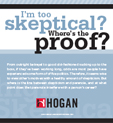 Is there such a thing as being too creative? Although creativity is largely associated with positive work outcomes, our research shows that, in excess, creativity can be a powerful roadblock to career success.
Is there such a thing as being too creative? Although creativity is largely associated with positive work outcomes, our research shows that, in excess, creativity can be a powerful roadblock to career success.
To understand how creativity can harm an individual’s career, we must look at personality from two perspectives: bright-side personality and dark-side personality.
Bright-side personality describes the strengths and weaknesses people display when they are at their best. Dark-side personality describes personality characteristics that are strengths under normal circumstances. Under the increased stress, pressure, or boredom of most work environments, people tend to overuse those strengths, and they can become powerful career derailers.
Creative people often have parents who emphasize their uniqueness and favor creative expression over convention. As adults, their ability to comfortably work outside of societal norms makes creative individuals valuable sources of potentially important ideas. However, highly creative individuals also tend to focus too much on thinking outside the box, often at the cost of their ability to clearly explain their ideas or follow through.
For more on performance implications and recommendations for coaching highly creative individuals, download our white paper, Way Outside the Box.


 This axiom is all too relevant for entrepreneurs today. Companies like Google and Pixar embrace a collaborative and innovative culture with unconventional work hours and offices. Why do they go through such great lengths to foster their employees’ creativity? Because that’s what a creative employee’s personality demands.
This axiom is all too relevant for entrepreneurs today. Companies like Google and Pixar embrace a collaborative and innovative culture with unconventional work hours and offices. Why do they go through such great lengths to foster their employees’ creativity? Because that’s what a creative employee’s personality demands. After analyzing the personality profiles of Homer’s Greek heroes, Achilles and Agamemnon, Rastislav Duriš, an HR consultant, and Matus Porubjak, a philosophy professor, asked the question, “In which occupations, organizations or environments would these heroes prosper today?”
After analyzing the personality profiles of Homer’s Greek heroes, Achilles and Agamemnon, Rastislav Duriš, an HR consultant, and Matus Porubjak, a philosophy professor, asked the question, “In which occupations, organizations or environments would these heroes prosper today?” Most people have experienced some form of office politics, and it's wise to view other’s motives with a healthy amount of skepticism. But where is the line between skepticism and paranoia, and at what point does that paranoia interfere with a person’s career?
Most people have experienced some form of office politics, and it's wise to view other’s motives with a healthy amount of skepticism. But where is the line between skepticism and paranoia, and at what point does that paranoia interfere with a person’s career? When thinking about personality, one thing that we know is there is no such thing as a good or bad personality. It really depends on the job and situation. This is a point that we regularly emphasize to individuals and organizations. Along these same lines, we know that high scores on personality assessments do not inherently mean good things, and low scores do not always mean bad things – there are positives and negatives to both ends of the continuum. Having stated that, our scores do represent our reputations. Over the course of time people come to expect certain behaviors from us based on our past performances.
When thinking about personality, one thing that we know is there is no such thing as a good or bad personality. It really depends on the job and situation. This is a point that we regularly emphasize to individuals and organizations. Along these same lines, we know that high scores on personality assessments do not inherently mean good things, and low scores do not always mean bad things – there are positives and negatives to both ends of the continuum. Having stated that, our scores do represent our reputations. Over the course of time people come to expect certain behaviors from us based on our past performances.